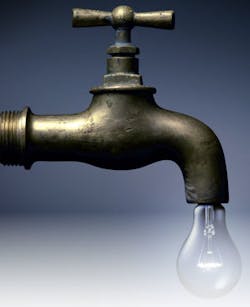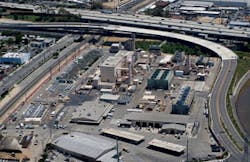The Missing Link: Increasing Public Awareness of the Interconnectedness of Water and Energy
Over the last couple of decades, energy and water professionals in industry, government and academia have begun to understand the importance of the water-energy nexus. However, solving the challenges and taking advantage of the opportunities that this nexus presents can never completely occur unless and until the general public understands what is taking place.
So, how much understanding, if any, does the general public have about the water-energy nexus? Not much, as it turns out. However, there are some encouraging developments in this area, especially as the topic gains prominence in discussions among some influential organizations.
On the international front, the International Energy Agency (IEA; www.worldenergyoutlook.org) noted that, for the first time, its World Energy Outlook 2012 examined the water-for-energy relationship, "reviewing water requirements for different energy sources and estimating total freshwater needs by scenario, energy source and region." The IEA added that water withdrawal by the energy sector is expected to rise by one-fifth through 2035, while the amount consumed (not returned directly to the environment) will increase by a more dramatic 85 percent.
The issue is also gaining domestic attention. For example, the National Conference of State Legislatures (NCSL; www.ncsl.org) noted, "State legislatures and natural resource managers have traditionally addressed water and energy as two separate issues." More recently, however, "resource managers and lawmakers across the country are beginning to take a comprehensive and interdisciplinary approach to the management of water and energy." For example, "States are beginning to assess their energy options and promote policies that allocate financial support to a diverse range of technologies to encourage responsible, sustainable energy production. States are also becoming aware of the limitations to accessible water, and, as our energy demands grow, competition for water among municipalities, farmers, industry, and power suppliers will increase.
"Water and energy are linked at both the supply side (electric generation and water/wastewater facilities) and the end-use side (residential, commercial, industrial, and agriculture sectors). In order to sustain energy production and a dependable water supply, the U.S. must gain a detailed understanding of the interdependence of water and energy systems and balance the needs of all users," the NCSL indicated. "State lawmakers and constituents will be critical in this process, given their responsibility for formulating policy, convening stakeholders, facilitating negotiations, and ratifying reached agreements."
Progress is beginning to occur, according to the NCSL, which noted that at least nine states -- Arizona, California, Colorado, Connecticut, Nevada, South Dakota, Washington, West Virginia, and Wisconsin -- have statutes that recognize the nexus between water and energy.
A third, well-known domestic organization attempting to raise awareness of the water-energy nexus is the U.S. Department of Energy (DOE), particularly through its Water-Energy Tech Team (WETT), which was formed in late 2012 to identify and pursue cross-cutting technology, data, modeling, analysis, and policy priorities for the Department relevant to the water-energy nexus. WETT also facilitates coordination of activities within the DOE and outreach to other stakeholders. The Department established WETT because the water- energy nexus is integral to two of its policy priorities -- climate change and energy security.
WETT has identified six "strategic pillars" that will serve as the foundation for coordinating research and development (R&D). These are:
- Optimizing the freshwater efficiency of energy production, electricity generation and end-use technologies
- Optimizing the energy efficiency of water management, treatment, distribution, and end-use technologies
- Enhancing the reliability and resilience of energy and water technologies
- Increasing safe and productive use of non-traditional water sources through improved technology
- Promoting responsible energy operations with respect to water quality, ecosystems and seismic impacts
- Exploiting productive synergies among water and energy system technologies
While working with experts is important to the success of WETT, the DOE emphasizes that many others have a critical role, including citizens. The WETT website noted that "WETT is working with partners, including other federal agencies, state and local governments, foreign governments, private industry, academic institutions, non-governmental organizations, and citizens, to pursue research, development and deployment of key technologies; shared robust datasets; integrated models to inform decision-making; harmonization of policies where warranted; and public dialogue."
According to Sean Bushart, director of generation environmental sciences for the Electric Power Research Institute (EPRI; www.epri.com), "People in general really understand the value of water and the challenges of limited water resources. In fact, water availability is a really hot topic these days in the news, especially in the western states."
However, Bushart noted that when it comes to the interdependent relationship between water and energy, the public's knowledge isn't as strong. "For example, there is a misunderstanding of water availability in terms of withdrawal and consumption for energy use," he said. On a national level, Bushart noted that water withdrawal for thermo-electric power plants (coal, nuclear, natural gas, etc.) is about 40 percent of freshwater, which is significant. However, from a consumption standpoint, it's only about 4 percent.
"The public also doesn't really understand that we use a fair amount of energy for the transport and use of water, especially as it relates to pumping," said Bushart. "So, when there is a limited availability of water and the potential for power shortages, these become two competing priorities. The public needs to understand that decisions need to be made as to how water will be used and how energy will be used, especially in terms of interacting with each other." For example, in certain situations, it could be necessary to endure a blackout in order to provide enough power to keep the water supply available.
In fact, according to Bushart, California is communicating with the public on the water-energy nexus because of the severe drought affecting the state. "I suspect that what is taking place there may also serve as a model for other states where drought conditions are occurring," he said.
Peter Newell, P.E., a water resources engineer with HDR, Inc. (www.hdrinc.com), agreed with Bushart. "Most people understand the value of water and energy as separate resources and how life could be very different without their current level of access to them," he said. "However, the interconnectedness of the water supply and energy resources requires a deeper understanding of how water supplies are developed, managed and treated, and how electricity is generated from various fuels." As Newell sees it, information about the nexus needs to be presented to the public in simple terms. "Provide data that link energy use to water consumed and water use to energy consumed," he said. "Help individuals see the impact of the decisions they make daily about these resources and why these decisions matter."
Vince Tidwell, a distinguished member of the technical staff at Sandia National Laboratories (SNL; www.sandia.gov), had a similar assessment. "My guess is that most people don't realize how many places energy touches water and water touches energy," he said. "In terms of addressing this, you can't minimize the role of the media in getting information out to people. It doesn't need to be sensationalized but rather presented in a way that can raise awareness." One way the media can do this, he believes, is to couple the water-energy nexus issue with the climate issue -- a topic that many people are very interested in. "So much of the climate issue is related to energy, so the media can emphasize just how much energy sources rely on water," Tidwell said.
Currently, Tidwell and others at SNL are working on an integrated planning process, designed to convene water and energy managers throughout the Western United States to analyze the problem and develop a solution together.
"This seems awfully simple, but it doesn't always happen that way," Tidwell said. "One thing we are doing is helping energy managers understand potential climate vulnerabilities to the current suite of power plants to help identify where some adaptations or mitigations might make sense to make these plants more resilient to drought and storms. We are also helping them plan where it would make sense to site new power plants, particularly plants that need water. We are also looking at different sources of water availability beyond just freshwater, including brackish groundwater and wastewater."
While these partnerships between water and energy managers may not directly enhance the water-energy nexus message to the public, it is a very important place to start, according to Heather Cooley, director of the water program at the Pacific Institute (PI; www.pacinst.org). Cooley, like Tidwell, sees the value of water and electric utilities working together, even in ways that can more directly impact members of the public.
"I don't think the public yet understands the connection between water and energy," said Cooley. "There are a lot of opportunities to educate the public about this, especially as it relates to solutions. People understand the challenges facing the energy sector and the water sector. However, because they don't understand the connection between the two, there is a shortage of win-win solutions."
One solution is to find ways to improve both water and energy efficiency -- to look at opportunities to manage water and energy resources in an integrated way. That is, there are ways to reduce water that will also save energy, as well as ways to reduce energy that will also save water, according to Cooley. For example, using less hot water saves water and energy directly. "However, people don't realize that by even using less cold water, it not only saves water but saves upstream and downstream energy, such as energy required to pump the water to where it's being used, as well as the energy required to treat the wastewater," she said. And, by reducing energy usage, since energy is a major user of water, this saves energy and water.
Cooley believes that the discussion can be extended to renewable energy. To date, the main focus of discussion on renewable energy has been how it reduces greenhouse gases (GHGs). However, she believes that the fact that renewable energy also tends to use less water should be added to the dialog. "Of course, there are some exceptions," she acknowledged, "such as solar thermal, which is a major user of water, depending on how the system is cooled."
So how does Cooley see water and energy managers working together to build public awareness of the water-energy nexus? An ideal approach is to provide financial incentives. "Water and electric utilities can and should work together to get the message across, especially with rebates," she said. Currently, many electric utilities offer rebates for appliances that use less energy but may actually use more water. For example, there are some ice machines that electric utilities implement because they use less energy. However, these same systems actually end up using more water. Conversely, some water utilities may offer rebates for appliances that use less water but may actually end up using more electricity.
According to Cooley, it would make sense for water and electric utilities in the same geographical location to work together to identify the appliances that use less energy and less water, as well as offer combined rebates to customers for these specific appliances. "Examples of these include front-loading washing machines," she said. "Besides providing these combined incentives to help customers save even more money, the combined rebate program makes it easier for customers who only have to apply for one rebate rather than two."
Beyond this, electric and water utilities can and should combine their general educational efforts. That is, rather than the local electric utility educating the public on only energy and the local water utility educating the public on only water, both utilities should work together to create a combined education program on energy and water. "Besides being more effective, of course, it also ends up being less expensive," said Cooley. And, just as importantly, it eliminates the risk of the two utilities inadvertently publicizing conflicting information, which would only serve to confuse the public and cause them to lose interest in both.
About the Author: William Atkinson is a correspondent for WaterWorld Magazine. He has been a full-time freelance business magazine writer since 1976, specializing in infrastructure, sustainability, supply chain, risk management, and safety/health.
Halifax Water: Reducing Water Loss in Real Time
In some areas, up to 50 percent of treated drinking water is lost due to leakage in the water distribution network. This translates into wasted energy. Consider that in California, for example, 7 percent of total energy consumption is used for water distribution.
In addition to instrumentation and process control systems, a real-time data management infrastructure is an important first step for any optimization or analysis to be achieved effectively.
Halifax Water in Canada, for example, manages water and wastewater for about 325,000 residents. The water distribution network consists of 1,300 km of pipe, and it manages water loss in real-time to save 38 million liters of water per day.
As a result of its adoption of the IWA/AWWA framework and technology integration with OSISoft's PI System, Halifax Water has reduced leakage of potable water from its distribution system from an Infrastructure Leakage Index (ILI) of 9.0 to 3.0, translating to a direct savings of almost $600,000 per year.1
Using the PI System, Halifax Water has created a real-time water loss calculator (see Figure) and electronic whiteboard that provides a dashboard for benchmarking regional (district metered areas) night flows compared to actuals. This provides the necessary information in real time to make optimal operating decisions and identify out-of-spec flow profiles that may entail a leak.
By reducing water loss, less energy is consumed, and both have a positive, sustainable impact on the environment.
To read the full case study, visit http://pages.osisoft.com/HalifaxCS.html.
References
1. Yates, C., MacDonald, G. "Water Loss Control: Sustainability on Both Sides of the Meter." Water Loss Control Report, IWA, Capetown, 2009.
GW&P Addresses the Water-Energy Nexus
Glendale Water & Power (GW&P) is a municipal utility that serves the citizens of Glendale, Calif., including approximately 34,500 water and 85,000 electric customers. As a water and electric utility, GW&P has a unique opportunity to address the interdependence of water and energy. The extraction, purification, pumping, treatment, and transportation of water all require vast amounts of energy. With the help of advanced metering infrastructure (AMI), GW&P is optimizing this connection between water and energy.
Recently, GW&P began implementing a program to use water and electric AMI data to optimize reservoir levels. With the goal of reducing pumping costs, the utility is evaluating supply and demand conditions so it can implement pumping during off-peak periods. Coordinating the electric time-of-use for pumping supports the optimization of storage and reduces energy costs for pumping. AMI plays an important role in determining demand at the meter level for an accurate measurement of interval usage.
In addition, GW&P will soon implement its WaterSmart Program to educate its customers about how much water their household uses, how they compare to neighbors and how they can save water and money. The program includes personalized water usage reports and an online portal. The utility is also looking into expanding its use of in-home displays to help customers manage their energy use.
Source: Itron and Glendale Water & Power
More WaterWorld Current Issue Articles
More WaterWorld Archives Issue Articles





